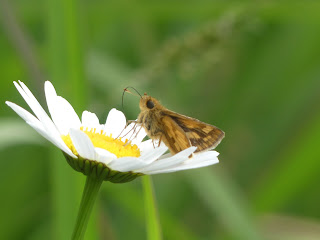Spotted Lanternflies
As Spotted Lanternflies spread through the area, I see the full spectrum of responses:
The next oldest stage has them looking black-and-red with white spots.
- Occasionally I see people who have little or no idea about them. (Usually these are from people living in areas where the Spotted Lanternfly isn't yet prominent.)
- There is a Facebook group I'm in where people have heard about the threat of Spotted Lanternflies, but they misidentify all but the most recognizable insects as Spotted Lanternflies, frequently will the "kill it" advice. (If you're advising people to kill something, it's a good idea to have the right insect.)
- But there are quite a few people who are getting fairly knowledgeable about Spotted Lanternflies, knowing what they are and killing them in a variety of ways. (Many times children have heard about them, presumably from school.)
For an extremely abundant invasive insect, the Spotted Lanternfly isn't known for its brilliant strategy. They can be trapped fairly effectively without chemicals by taking advantage of their tendency to climb up trees. If you're looking for something more selective/manual, a simple bottle technique takes advantage of their tendency to jump when a threat is perceived.
The Spotted Lanternfly looks differently depending on their life stage, which corresponds loosely to the seasons. Right now we're seeing adults; you can slightly see the red on the back wings through the front wings covering them.
 |
| August 3, 2021 at Washington Valley Park Photo 149026405, (c) jpviolette, some rights reserved (CC BY-NC) |
The next oldest stage has them looking black-and-red with white spots.
 |
| July 22, 2021 at Fairview Farm Photo 148399857, (c) jpviolette, some rights reserved (CC BY-NC) |
And when they're even younger than that, they'll look black with white spots like this.
 |
| June 23, 2021 at Duke Farms Photo 141960902, (c) jpviolette, some rights reserved (CC BY-NC) |



Comments
Post a Comment